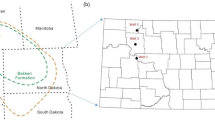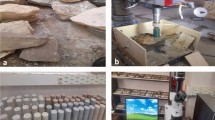Abstract
The strength of water-bearing rock cannot be obtained in real time and by nondestructive experiments, which is an issue at cultural relics protection sites such as grotto temples. To solve this problem, we conducted a near-infrared spectrum acquisition experiment in the field and laboratory uniaxial compression strength tests on sandstone that had different water saturation levels. The correlations between the peak height and peak area of the near-infrared absorption bands of the water-bearing sandstone and uniaxial compressive strength were analyzed. On this basis, a strength prediction model for water-bearing sandstone was established using the long short-term memory full convolutional network (LSTM-FCN) method. Subsequently, a field engineering test was carried out. The results showed that: (1) The sandstone samples had four distinct characteristic absorption peaks at 1400, 1900, 2200, and 2325 nm. The peak height and peak area of the absorption bands near 1400 nm and 1900 nm had a negative correlation with uniaxial compressive strength. The peak height and peak area of the absorption bands near 2200 nm and 2325 nm had nonlinear positive correlations with uniaxial compressive strength. (2) The LSTM-FCN method was used to establish a strength prediction model for water-bearing sandstone based on near-infrared spectroscopy, and the model achieved an accuracy of up to 97.52%. (3) The prediction model was used to realize non-destructive, quantitative, and real-time determination of uniaxial compressive strength; this represents a new method for the non-destructive testing of grotto rock mass at sites of cultural relics protection.
Similar content being viewed by others
References
Arganosa GC, Warkentin TD, Racz VJ, et al. (2006) Prediction of crude protein content in field peas using near infrared. Can J Plant Sci 86:157–159. https://doi.org/10.4141/P04-195
Cherblanc F, Berthonneau J, Bromblet P, et al. (2016) Influence of water content on the mechanical behaviour of limestone: role of the clay minerals content. Rock Mech Rock Eng 49:2033–2042. https://doi.org/10.1007/s00603-015-0911-y
Gou Y, Wei J, Li JL, et al. (2020) Estimating purple-soil moisture content using Vis-NIR spectroscopy. J Mt Sci 17: 2214–2223. https://doi.org/10.1007/s11629-019-5848-2
Hayes DJM (2012) Development of near infrared spectroscopy models for the quantitative prediction of the lignocellulosic components of wet Miscanthus samples. Bioresour Technol 119:393–405. https://doi.org/10.1016/j.biortech.2012.05.137
Huang Z, Zhang W, Zhang H, et al. (2022) Damage characteristics and new constitutive model of sandstone under wet-dry cycles. J Mt Sci 19:2111–2125. https://doi.org/10.1007/s11629-021-7239-8
Konrad F, Stalder R, Tessadri R (2015) Quantitative phase analysis of lateritic bauxite with NIR-spectroscopy. Miner Eng 77:117–120. https://doi.org/10.1016/j.mineng.2015.03.005
Karim F, Majumdar S, Darabi H, et al. (2018) LSTM fully convolutional networks for time series classification. IEEE Access 6:1662–1669. https://doi.org/10.1109/ACCESS.2017.2779939
Karim F, Majumdar S, Darabi H (2019) Insights into LSTM fully convolutional networks for time series classification. IEEE Access 7:67718–67725. https://doi.org/10.1109/ACCESS.2019.2916828
Kereszturi G, Heap M, Schaefer LN, et al. (2023) Porosity, strength, and alteration - Towards a new volcano stability assessment tool using VNIR-SWIR reflectance spectroscopy. Earth Planet Sc Lett 602: 117929. https://doi.org/10.1016/j.epsl.2022.117929
Liu Y, Lyon BG, Windham WR, et al. (2003) Prediction of color, texture, and sensory characteristics of beef steaks by visible and near infrared reflectance spectroscopy. a feasibility study. Meat Sci 65:1107–1115. https://doi.org/10.1016/S0309-1740(02)00328-5.
Schaefer LN, Kereszturi G, Villeneuve M, et al. (2021) Determining physical and mechanical volcanic rock properties via reflectance spectroscopy. J Volcanol Geoth Res J 420:107393. https://doi.org/10.1016/j.jvolgeores.2021.107393.
Post JL, Crawford SM (2014). Uses of near-infared spectra for the identification of clay minerals. Appl Clay Sci 95:383–387. https://doi.org/10.1016/j.clay.2014.02.010
MA Mahboob, B Genc, T Celik, et al. (2019) Mapping hydrothermal minerals using remotely sensed reflectance spectroscopy data from Landsat. J S Afr I Min Metall 119: 279–289. https://doi.org/10.17159/2411-9717/2019/v119n3a7.
Meng Z, He M, Tao Z, et al. (2020) Three-dimensional numerical modeling and roof deformation analysis of yuanjue cave based on point cloud data. Adv Civ Eng 23:1–13 https://doi.org/10.1155/2020/8825015
Clark RN, King TVV, Klejwa M, et al. (1990) High spectral resolution reflectance spectroscopy of minerals. J Geophys Res-Sol Ea 95(B8): 12653–12680. https://doi.org/10.1029/JB095iB08p12653
Ren W, Wang J, Li F, et al. (2017) Exploration and understanding for water hazard in Buddha Bay of Baoding Mountain, Dazu Rock Carvings. J Eng Geol https://doi.org/10.13544/j.cnki.jeg.2017.s1.085
Marsh SE, McKeon JB (1983) Integrated analysis of highresolution field and airborne spectroradiometer data for alteration mapping. Econ Geol 78(4): 618–632. https://doi.org/10.2113/gsecongeo.78.4.618
Nakashima S, Isono Y, Kimura T, et al. (2014) Visible and near infrared spectroscopy of rocks for rock strength evaluation. ISRM International Symposium - 8th Asian Rock Mechanics Symposium, Sapporo, Japan, pp 354–364.
Singh M, Rajesh VJ, Kannan B, et al. (2018) Spectral and chemical characterization of gypsum phyllosilicate association in Tiruchirapalli, South India, and its implications. Geol J 53: 1685–1697. https://doi.org/10.1002/gj.2990.
Wang D, Zhang Z, Fu L, et al. (1995) Characteristics of acid rain in Dazu County and its damage to stone carving. Hydrogeol Eng Geol 3:9–16. (In Chinese)
Wang Y, Hua P (1998) The environment, composition, and protection of dazu rock inscriptions. Environ Geol 33: 295–298. (In Chinese)
Xiu L, Zheng Z, Yu Z, et al. (2007) Mineral analysis technology application with near infrared spectroscopy in identifying alteration mineral. Acta Geol Sin 11:1584–1590. https://doi.org/10.1016/S1872-5791(07)60044-X.
Xiu L, Xiu T, Yu Z, et al. (2009) Study on method of measuring altered minerals in rocks with near-infrared spectrometer. Rock Miner Anal 28(006): 519–523. https://doi.org/10.1016/S1874-8651(10)60080-4.
Chen X, Fang Y, Chen X, et al. (2011) Risk assessment of disease of Niches’ Eaves in the Dazu Rock carvings based on GIS. Procedia Environ Sci 10:2748–2753. https://doi.org/10.1016/j.proenv.2011.09.426.
Yan S, Zhang B, Zhao Y, et al. (2003) Summarizing the VIS-NIR spectra of minerals and rocks. Remote Sens Technol App 18:191–201. (In Chinese)
Isono Y, Kimura T, Nakashima S (2014) Evaluation of hydration degrees of granitic rocks by near-infrared spectroscopy and their relations with rock strength. J Japan Soc Eng Geol 55:86–92. https://doi.org/10.5110/jjseg.55.86.
Yuan J, Wang Z. (2015) Review of time series representation and classification techniques. Comput Sci 42(3): 1–7. https://doi.org/10.11896/j.issn.1002-137X.2015.3.001
Zhang Z, Fu L, Yao J, et al. (1995) Lithological characters of carved sandstone in Dazu. J Chongqing Jianzhu Univ 17:58–62 (In Chinese)
Zhang X, Zhang F, Zhou N, et al. (2021) Near-infrared spectral feature selection of water-bearing rocks based on mutual information. Spectrosc Spect Anal 41(7):2028–2035. https://doi.org/10.3964/j.issn.1000-0593(2021)07-2028-08.
Zhang N, He M, Liu P (2012) Water vapor sorption and its mechanical effect on clay-bearing conglomerate selected from China. Eng Geol 141–142:1–8. https://doi.org/10.1016/j.enggeo.2012.04.007
Zhang B, Jiang S (2016) Preliminary exploration of water seepage disease on Big Buddha Bay of Dazu rock carving. China Cult Herit Sci Res 1:68–71. (In Chinese).
Zhang F, Zhang X, Hu C, et al. (2021) Classification and recognition model of water saturation level of rock based on near-infrared spectroscopy. Geotech Test J 44:20190413. https://doi.org/10.1520/GTJ201904
Zhu C, He M, Jiang B, et al. (2021) Numerical investigation on the fatigue failure characteristics of waterbearing sandstone under cyclic loading. J Mt Sci 18:3348–3365. https://doi.org/10.1007/s11629-021-6914-0
Acknowledgments
Many thanks to our colleagues who have contributed to this article. In particular, we would like to thank WANG Peng, ZHOU Nuan, and ZHANG Jing-jie, who assisted in the experimental simulation. This work was supported by the Zhejiang Provincial Collaborative Innovation Center of Mountain Geological Hazard Prevention (PCMGH-2021-05) and the Special Fund for Fundamental Research Business Expenses of Central Universities (Grant No. 600101110102).
Author information
Authors and Affiliations
Contributions
ZHANG Xiu-lian performed the data analyses and wrote the manuscript; ZHANG Fang contributed to the conception of the study; WANG Ya-zhe performed the experiment; TAO Zhi-gang helped perform the analysis with constructive discussions; ZHANG Xiao-yun contributed significantly to analysis and manuscript preparation.
Corresponding author
Ethics declarations
Data Availability: All the data included in this study are available upon request by contact with the corresponding author.
Conflict of Interest: The authors declared that they have no conflicts of interest to this work.
Rights and permissions
About this article
Cite this article
Zhang, Xl., Zhang, F., Wang, Yz. et al. Strength prediction model for water-bearing sandstone based on near-infrared spectroscopy. J. Mt. Sci. 20, 2388–2404 (2023). https://doi.org/10.1007/s11629-022-7796-5
Received:
Revised:
Accepted:
Published:
Issue Date:
DOI: https://doi.org/10.1007/s11629-022-7796-5




